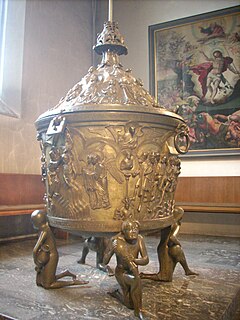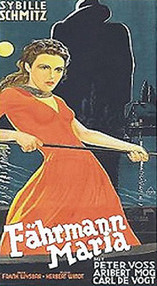
Bruno Bauer was a German philosopher and theologian. As a student of G. W. F. Hegel, Bauer was a radical Rationalist in philosophy, politics and Biblical criticism. Bauer investigated the sources of the New Testament and, beginning with Hegel's Hellenophile orientation, concluded that early Christianity owed more to ancient Greek philosophy (Stoicism) than to Judaism. Bruno Bauer is also known by his association and sharp break with Karl Marx and Friedrich Engels, and by his later association with Max Stirner and Friedrich Nietzsche. Starting in 1840, he began a series of works arguing that Jesus was a 2nd-century fusion of Jewish, Greek, and Roman theology.

Azriel Hildesheimer was a German rabbi and leader of Orthodox Judaism. He is regarded as a pioneering moderniser of Orthodox Judaism in Germany and as a founder of Modern Orthodox Judaism.

Hildesheim Cathedral, officially the Cathedral of the Assumption of Mary or simply St. Mary's Cathedral, is a medieval Roman Catholic cathedral in the city centre of Hildesheim, Germany, that serves as the seat of the Diocese of Hildesheim. The cathedral has been on the UNESCO World Cultural Heritage list since 1985, together with the nearby St. Michael's Church.

Bremen Cathedral, dedicated to St. Peter, is a church situated in the market square in the center of Bremen. The cathedral belongs to the Bremian Evangelical Church, a member of the Protestant umbrella organization named Evangelical Church in Germany. It is the previous cathedral of the former Prince-Archbishopric of Bremen. Since 1973, it is protected by the monument protection act.
Jakob Guttmann was a German theologian and philosopher of religion (Religionsphilosoph). He officiated as chief rabbi of the Land rabbinate of Hildesheim between 1874 and 1892. Thereafter he served as rabbi in Breslau until his death.
Abraham Lewinsky was a late nineteenth to early twentieth century German rabbi. He was born on March 1, 1866, in Loslau, Upper Silesia, Kingdom of Prussia. He studied at the University of Breslau from 1884 to 1887, obtaining a (Ph.D.), while pursuing his rabbinical studies at the Jewish Theological Seminary in Breslau. In 1890 he became rabbi to Weilburg, and two years later assumed leadership as land rabbi of the Land Rabbinate of Hildesheim in the Province of Hanover, retiring in 1935. He died December 18, 1941, in Mainz, People's State of Hesse.

Essen Minster, since 1958 also Essen Cathedral is the seat of the Roman Catholic Bishop of Essen, the "Diocese of the Ruhr", founded in 1958. The church, dedicated to Saints Cosmas and Damian and the Blessed Virgin Mary, stands on the Burgplatz in the centre of the city of Essen, Germany.
Hezilo of Hildesheim, also known as Hezelo, Hettilo or Ethilo, was Bishop of Hildesheim from 1054 to 1079.

The Lübeck Martyrs were three Roman Catholic priests – Johannes Prassek, Eduard Müller and Hermann Lange – and the Evangelical-Lutheran pastor Karl Friedrich Stellbrink. All four were executed by beheading on 10 November 1943 less than 3 minutes apart from each other at Hamburg's Holstenglacis Prison. Eyewitnesses reported that the blood of the four clergymen literally ran together on the guillotine and on the floor. This impressed contemporaries as a symbol of the ecumenical character of the men's work and witness. That interpretation is supported by their last letters from prison, and statements they themselves made during their time of suffering, torture and imprisonment. "We are like brothers," Hermann Lange said.

Henry III of Brunswick-Lüneburg was the ruling Prince-Bishop of Hildesheim from 1331 until his death.

The Liuthar Gospels are a work of Ottonian illumination which are counted among the masterpieces of the period known as the Ottonian Renaissance. The manuscript, named after a monk called Liuthar, was probably created around the year 1000 at the order of Otto III at the Abbey of Reichenau and lends its name to the Liuthar Group of Reichenau illuminated manuscripts. The backgrounds of all the images are illuminated in gold leaf, a seminal innovation in western illumination.

The Hezilo chandelier is an 11th-century Romanesque wheel chandelier. It is part of the treasures of the Hildesheim Cathedral in Hildesheim, Germany, which has been a UNESCO World Cultural Heritage site since 1985. The chandelier was most likely commissioned by Bishop Hezilo of Hildesheim, who rebuilt the cathedral after a fire. He probably also influenced the program of imagery and inscriptions. It is the largest of four extant wheel chandeliers of the period; the others surviving examples are the Azelin chandelier, the Barbarossa chandelier in the Aachen Cathedral, and the Hartwig chandelier in the Abbey of Comburg.

The Azelin chandelier is a Romanesque wheel chandelier, made in the 11th century for the Hildesheim Cathedral in Hildesheim, Germany, a UNESCO World Cultural Heritage site since 1985. It is the oldest of four extant wheel chandeliers from that period, along with the Hezilo chandelier, also in Hildesheim, the Barbarossa chandelier in the Aachen Cathedral, and the Hartwig chandelier in the Abbey of Comburg. It was believed to be donated by Bishop Azelin, however his predecessor Thietmar is more likely to be the patron. Therefore, the chandelier is also called the Thietmar chandelier (Thietmarleuchter).

The Bernward Doors are the two leaves of a pair of Ottonian or Romanesque bronze doors, made c. 1015 for Hildesheim Cathedral in Germany. They were commissioned by Bishop Bernward of Hildesheim (938–1022). The doors show relief images from the Bible, scenes from the Book of Genesis on the left door and from the life of Jesus on the right door. They are considered a masterpiece of Ottonian art, and feature the oldest known monumental image cycle in German sculpture, and also the oldest cycle of images cast in metal in Germany.

The Bernward Column also known as the Christ Column is a Romanesque bronze column, made c. 1000 for St. Michael's Church in Hildesheim, Germany, and regarded as a masterpiece of Ottonian art. It was commissioned by Bernward, thirteenth bishop of Hildesheim. It depicts images from the life of Jesus, arranged in a helix similar to Trajan's Column: it was originally topped with a cross or crucifix. During the 19th century, it was moved to a courtyard and later to Hildesheim Cathedral. During the restoration of the cathedral from 2010 to 2014, it was moved back to its original location in St. Michael's, but was returned to the Cathedral in August 2014.

The Bronze baptismal font in the Hildesheim Cathedral is a late Romanesque baptismal font which was probably made in Hildesheim in the first third of the thirteenth century. It is noted for its pictorial decoration which is of the highest quality and for its perfect proportions and is considered among the most outstanding works of its type. For centuries the baptismal font stood in the western part of the nave, until it was moved to the last of the northern side-chapels in 1653. During the ongoing renovations of the cathedral (2010–2014) it is being displayed in the Bode Museum in Berlin. After the completion of the renovation work, it will be placed in the centre of the nave under the Hezilo chandelier.

The Hildesheim Cathedral Museum is the treasury and diocesan museum of Hildesheim, which illustrates over a thousand years of art and church history in Lower Saxony. It is located in historic rooms off the southern transept of the Hildesheim Cathedral. During the cathedral renovations of 2010, the nearby church of St Antonius and part of the cathedral cloisters were converted into display rooms for the museum.

The Meister des Göttinger Barfüßeraltars was a Gothic German painter in Göttingen known for the creation of a large altarpiece in the Franciscan Church there in 1424. Although the church was demolished in around 1824, the altarpiece can be seen in the Lower Saxony State Museum in Hanover. The painting is 7.87 meters wide and 3.06 meters high, the largest preserved Gothic altarpiece in Lower Saxony (Niedersachsen). It was restored in 2005 after six years of work at a cost of 1.2 million euros.

The Mastaba of Seshemnefer IV is a mastaba tomb in Cemetery GIS of the Giza Necropolis in Egypt. It dates from the early Sixth Dynasty, and was built for the official Seshemnefer IV. Five reliefs from the mastaba of Seshemnefer IV are on display in the Egyptian collection of the Roemer- und Pelizaeus-Museum Hildesheim.

Fährmann Maria is a 1936 German horror film film directed by Frank Wisbar and starring Sybille Schmitz.

















